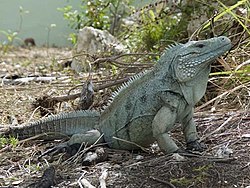The Iguanidae is a family of lizards composed of the iguanas, chuckwallas, and their prehistoric relatives, [1] including the widespread green iguana.
The Iguanidae is a family of lizards composed of the iguanas, chuckwallas, and their prehistoric relatives, [1] including the widespread green iguana.
Iguanidae is thought to be the sister group to the collared lizards (family Crotaphytidae). This family likely first appeared in Cenozoic, previously identified two Cretaceous genera ( Pristiguana and Pariguana ) are unlikely to belong to this family. [2] The subfamily Iguaninae, which contains all modern genera, likely originated in the earliest Paleocene, about 62 million years ago. The most basal extant genus, Dipsosaurus, diverged from the rest of Iguaninae during the late Eocene, about 38 million years ago, with Brachylophus following a few million years later at about 35 million years ago, presumably after its dispersal event to the Pacific. All other modern iguana genera formed in the Neogene period. [3]
A phylogenetic tree of Iguaninae is shown here: [3]
Iguanas and iguana-type species are diverse in terms of size, appearance, and habitat. They typically flourish in tropical, warm climates, such as regions of South America and islands in the Caribbean and in the Pacific. Iguanas typically possess dorsal spines across their back, a dewlap on the neck, sharp claws, a long whip-like tail, and a stocky, squat build. Most iguanas are arboreal, living in trees, but some species tend to be more terrestrial, which means they prefer the ground. Iguanas are typically herbivores and their diets vary based on what plant life is available within their habitat. Iguanas across many species remain oviparious, and exhibit little to no parental care when their eggs hatch. They do, however, display nest-guarding behavior. Like all extant non-avian reptiles, they are poikilothermic, and also rely on regular periods of basking under the sun to thermoregulate. [4]
All but one of the modern iguana genera are native to the Americas, ranging from the deserts of the Southwestern United States through Mexico, Central America, and the Caribbean, to throughout South America down to northernmost Argentina. Some iguanas like I. iguana have spread from their native regions of Central and South America into many Pacific Islands, and even to Fiji, Japan, and Hawaiʻi, due to the exotic pet trade and illegal introductions into the ecosystems. [5] Other iguanas, like the Galapagos pink iguana (C. marthae) are endemic only to specific regions on the Galapagos islands. The Grand Cayman blue iguana, C. lewisi, is endemic only to the Grand Cayman island, limited to a small wildlife reserve. [4] The only non-American iguana species are the members of the genus Brachylophus and the extinct Lapitiguana , which are found on Fiji and formerly Tonga; their distribution is thought to be the result of the longest overwater dispersal event ever recorded for a vertebrate species, with them rafting over 8000 km across the Pacific from the Americas to the Fiji and Tonga. [6]
| Image | Genus | Species |
|---|---|---|
 | Amblyrhynchus Bell, 1825 – marine iguana |
|
 | Brachylophus Cuvier, 1829 – Fijian/Tongan iguanas |
|
 | Cachryx Cope, 1866 – spinytail iguanas |
|
 | Conolophus Fitzinger, 1843 – Galápagos land iguanas |
|
 | Ctenosaura Wiegmann, 1828 – spiny-tailed iguanas |
|
 | Cyclura Harlan, 1825 – West Indian rock iguanas |
|
 | Dipsosaurus Hallowell, 1854 – desert iguanas |
|
 | Iguana Laurenti, 1768 – green and Lesser Antillean iguanas |
|
 | Sauromalus Dumeril, 1856 – chuckwallas |
|
| Image | Genus | Species |
|---|---|---|
 | Armandisaurus Norell & de Queiroz, 1991 |
|
 | Lapitiguana Pregill & Worthy, 2003 |
|
 | Pumilia Norell 1989 |
|
Cretaceous Pristiguana brasiliensis and Pariguana lancensis are later excluded from the family. [7] [2]
Several classification schemes have been used to define the structure of this family. The "historical" classification recognized all New World iguanians, plus Brachylophus and the Madagascar oplurines, as informal groups and not as formal subfamilies. [8]
Frost and Etheridge (1989) formally recognized these informal groupings as families. [9] [10]
Macey et al. (1997), in their analysis of molecular data for iguanian lizards recovered a monophyletic Iguanidae and formally recognized the eight families proposed by Frost and Etheridge (1989) as subfamilies of Iguanidae. [11]
Schulte et al. (2003) reanalyzed the morphological data of Frost and Etheridge in combination with molecular data for all major groups of Iguanidae and recovered a monophyletic Iguanidae, but the subfamilies Polychrotinae and Tropidurinae were not monophyletic. [12]
Townsend et al. (2011), Wiens et al. (2012) and Pyron et al. (2013), in the most comprehensive phylogenies published to date, recognized most groups at family level, resulting in a narrower definition of Iguanidae. [13] [14] [15]
Family Iguanidae
Family Corytophanidae
Family Crotaphytidae
Family Hoplocercidae
Family Iguanidae
Family Opluridae
Family Phrynosomatidae
Family Polychridae
Family Tropiduridae
Family Iguanidae
Here families and subfamilies are proposed as clade names, but may be recognized under the traditional Linnean nomenclature.
Iguanidae
{{cite journal}}: CS1 maint: multiple names: authors list (link){{cite journal}}: CS1 maint: multiple names: authors list (link)